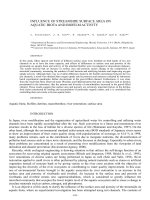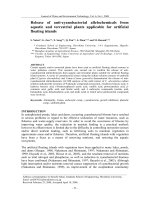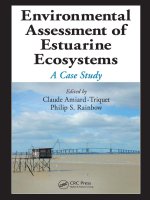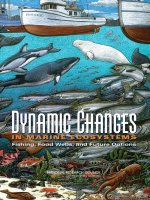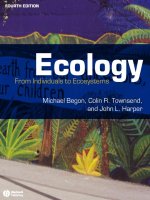Aquatic ecosystems
Bạn đang xem bản rút gọn của tài liệu. Xem và tải ngay bản đầy đủ của tài liệu tại đây (5.68 MB, 533 trang )
Aquatic Ecosystems:
Interactivity of Dissolved
Organic Matter
AQUATIC ECOLOGY Series
Series Editor
James H. Thorp
Department of Biology
University of Louisville
Louisville, Kentucky
Other titles in the series:
Groundwater Ecology
Janine Gilbert, Dan L. Danielopol, Jack A. Stanford
Algal Ecology
R. Jan Stevenson, Max L. Bothwell, Rex L. Lowe
Streams and Ground Waters
Jeremy B. Jones, Patrick J. Mulholland
Aquatic
Ecosystems
Interactivity of
Dissolved Organic
Matter
Edited by
Stuart E. G. Findlay
Institute of Ecosystem Studies
Millbrook, New York
Robert L. Sinsabaugh
Department of Biology
University of Toledo
Toledo, Ohio
Amsterdam Boston London New York Oxford Paris San Diego
San Francisco Singapore Sydney Tokyo
This book is printed on acid-free paper.
Copyright 2003, Elsevier Science (USA)
All rights reserved.
No part of this publication may be reproduced or transmitted in any form or by any means,
electronic or mechanical, including photocopy, recording, or any information storage and
retrieval system, without permission in writing from the publisher.
The appearance of the code at the bottom of the first page of a chapter in this book
indicates the Publisher’s consent that copies of the chapter may be made for personal or
internal use of specific clients. This consent is given on the condition, however, that the
copier pay the stated per copy fee through the Copyright Clearance Center, Inc.
(www.copyright.com), for copying beyond that permitted by Sections 107 or 108 of the U.S.
Copyright Law. This consent does not extend to other kinds of copying, such as copying for
general distribution, for advertising or promotional purposes, for creating new collective
works, or for resale. Copy fees for pre-2003 chapters are as shown on the title pages. If no
fee code appears on the title page, the copy fee is the same as for current chapters. $35.00
Explicit permission from Academic Press is not required to reproduce a maximum of two
figures or tables from an Academic Press chapter in another scientific or research publication
provided that the material has not been credited to another source and that full credit to the
Academic Press chapter is given.
Cover photo credit: Lonna Kelly (c)
Academic Press
An imprint of Elsevier Science
525 B Street, Suite 1900, San Diego, California 92101-4495, USA
Academic Press
An imprint of Elsevier Science
84 Theobald’s Road, London WC1X 8RR, UK
Library of Congress Control Number: 2002107706
International Standard Book Number: 0-12-256371-9
PRINTED IN THE UNITED STATES OF AMERICA
0203040506MB987654321
Contents
Contributors xiii
Preface xvii
SECTION
ONE
SOURCES AND COMPOSITION
1 Supply of Dissolved Organic Matter to Aquatic
Ecosystems: Autochthonous Sources
Stefan Bertilsson and Jeremy B. Jones, Jr.
I. Introduction 3
II. Algal Sources of Dissolved Organic Matter 4
III. Macrophyte Production of Dissolved
Organic Matter 15
v
IV. Summary 18
References 19
2 Sources, Production, and Regulation of
Allochthonous Dissolved Organic Matter
Inputs to Surface Waters
J. A. Aitkenhead-Peterson, W. H. McDowell, and J. C. Neff
I. Introduction 26
II. Source, Production, and Fractions of Dissolved
Organic Matter 28
III. Regulation of Allochthonous Dissolved Organic
Carbon and Dissolved Organic Nitrogen 51
References 59
3 Trace Organic Moieties of Dissolved Organic
Material in Natural Waters
D. M. McKnight, E. Hood, and L. Klapper
I. Introduction 71
II. Tracers of the Source of DOM in
Aquatic Ecosystems 74
III. Biogeochemical Processes: Interactions with
Mineral Surfaces 86
IV. Biogeochemical Processes: Surface Water
to Sediments 88
V. Conclusions 91
References 93
4 The Role of Monomers in Stream
Ecosystem Metabolism
L. A. Kaplan and J. D. Newbold
I. Introduction 97
II. Monomer Sources and Concentrations 99
III. Factors Affecting Biological Lability 106
IV. Conclusions 112
References 113
vi Contents
5 Molecular Indicators of the Bioavailability of
Dissolved Organic Matter
R. Benner
I. Introduction 121
II. Chemical Composition of Dissolved
Organic Matter 122
III. Bioreactivity of Dissolved Organic Matter 128
IV. Relationships between the Chemical Composition
and Bioreactivity of Dissolved Organic Matter 129
References 135
6 Large-Scale Patterns in Dissolved Organic
Carbon Concentration, Flux, and Sources
P. J. Mulholland
I. Introduction 139
II. Dissolved Organic Carbon Concentrations 140
III. Dissolved Organic Carbon Exports in Rivers
and Streams 147
IV. Sources of Dissolved Organic Carbon 152
V. Synthesis and Future Research Needs 154
References 157
7 The Speciation of Hydrophobic Organic
Compounds by Dissolved Organic Matter
Yu-Ping Chin
I. Introduction 161
II. Theoretical Considerations 163
III. Analytical Methods for Measuring K
dom
167
IV. The Effect of Dissolved Organic Matter
Composition on Hydrophobic Organic
Contaminant Speciation 174
V. Effects of Dissolved Organic Matter on
Hydrophobic Organic Contaminant
Bioavailability to Aquatic Organisms 178
VI. Conclusions 179
References 180
Contents vii
8 Elemental Complexation by Dissolved Organic
Matter in Lakes: Implications for Fe Speciation
and the Bioavailability of Fe and P
R. Maranger and M. J. Pullin
I. Introduction 186
II. Biological Importance of Fe 189
III. Biological Fe Demand in Brown- versus
Clear-Water Systems 190
IV. DOM and Fe Chemistry in Freshwater 192
V. The DOM-Fe-P Complex in Lakes 194
VI. Factors Influencing the Bioavailability of Fe and P
Bound to DOM 199
VII. Elemental Acquisition in Humic Lakes: Implications
for Ecosystem Structure and Function 205
VIII. Conclusions 206
References 207
SECTION
TWO
TRANSFORMATION AND REGULATION
9 The Contribution of Monomers and Other
Low-Molecular Weight Compounds to
the Flux of Dissolved Organic Material in
Aquatic Ecosystems
D. L. Kirchman
I. Introduction 218
II. Uptake of Amino Acids and Glucose 218
III. Uptake of Other Monomers and LMW Compounds:
Organic Acids 226
IV. Respiration of Monomers 228
V. Coupling Polymer Hydrolysis and
Monomer Uptake 229
VI. Specific Bacteria Using Amino Acids and Protein:
Functional Groups of Heterotrophic Bacteria 232
VII. Heterotrophic Bacteria as More Than One
Functional Group: Does It Matter? 235
VIII. Unknowns, Unresolved Issues, and Conclusions 236
References 237
viii Contents
10 Photochemically Mediated Linkages
between Dissolved Organic Matter
and Bacterioplankton
M. A. Moran and J. S. Covert
I. Introduction 244
II. Is Dissolved Organic Matter Photoproduct
Formation Predictable? 245
III. Is Dissolved Organic Matter Photoproduct
Formation Ecologically Significant? 255
IV. Photochemical Modifications of Dissolved Organic
Nitrogen and Dissolved Organic Phosphorus 258
V. Conclusions 258
References 259
11 The Importance of Organic Nitrogen Production in
Aquatic Systems: A Landscape Perspective
N. F. Caraco and J. J. Cole
I. Introduction 263
II. Model 268
III. System Results 269
IV. Discussion 276
References 279
12 The Role of Biofilms in the Uptake and
Transformation of Dissolved Organic Matter
Helmut Fischer
I. Introduction 285
II. Biofilm Structure 288
III. Supply of Dissolved Organic Matter to
Biofilm Bacteria 289
IV. Effects of the Biofilm on Microbial Activity 299
V. Effects of Dissolved Organic Matter
Quality and Quantity on the Activity of
Biofilm Bacteria 300
VI. Ecosystem Consequences 304
VII. Conclusions 306
References 306
Contents ix
13 Microbial Extracellular Enzymes and Their Role
in Dissolved Organic Matter Cycling
C. Arnosti
I. The Role of Extracellular Enzymes in Carbon
Remineralization 316
II. Biochemical Aspects of Enzyme Production
and Activity 316
III. Measuring Enzyme Activities in Aquatic
Systems 319
IV. Extracellular Enzyme Activities in the Water
Column and Sediment 321
V. Patterns of Enzyme Activities 324
VI. Relationships between Hydrolysis and Uptake 327
VII. Some Key Questions 330
VIII. Research Needs 336
References 337
14 Linkages between Dissolved Organic
Matter Composition and Bacterial
Community Structure
C. M. Foreman and J. S. Covert
I. Introduction 343
II. Methodological Shift 345
III. Relationship between Bacterial Community
Structure and Dissolved Organic Matter
Composition 348
IV. Conclusions 356
References 359
15 Bacterial Response to Variation in
Dissolved Organic Matter
S. Findlay
I. Introduction 363
II. Bacterial Response Variables 364
III. Time Scale and Scope of Bacterial
Response Variables 373
IV. Conclusions 376
References 377
x Contents
SECTION
THREE
APPROACHES TO SYNTHESIS
16 Physiological Models in the Context of
Microbial Food Webs
T. Frede Thingstad
I. Introduction 383
II. Trophic Mechanisms Controlling Bacterial
Consumption 384
III. Organic Forms of Limiting Element (Labile
Dissolved Organic Nitrogen and Dissolved Organic
Phosphorus) 388
IV. Bacterial Physiology 389
V. Dissolved Organic Matter Production Side 392
VI. Conclusions 395
References 395
17 Patterns in Dissolved Organic Matter Lability
and Consumption across Aquatic Ecosystems
P. A. del Giorgio and J. Davis
I. Introduction 400
II. Data Collection 402
III. Data Analysis 405
IV. Patterns of Dissolved Organic Matter Lability
among Systems 407
V. Lability of Specific Types of Dissolved
Organic Matter 409
VI. Cross-System Patterns in Dissolved Organic
Matter Consumption 410
VII. Patterns of Lability along Dissolved Organic
Matter Gradients 412
VIII. Temporal Patterns in Dissolved Organic
Matter Lability 414
IX. Bioassay versus Metabolic Estimates of Dissolved
Organic Matter Consumption 414
X. Factors That Influence Dissolved Organic Matter
Lability in Bioassays 417
XI. Conclusions 419
References 420
Contents xi
18 Integrating Dissolved Organic Matter
Metabolism and Microbial Diversity:
An Overview of Conceptual Models
R. L. Sinsabaugh and C. M. Foreman
I. Introduction 426
II. Community Structure Domain 426
III. Biogeochemical Domain 430
IV. Trophic Domain 439
V. Summary 448
References 449
19 Dissolved Organic Carbon: Detrital Energetics,
Metabolic Regulators, and Drivers of Ecosystem
Stability of Aquatic Ecosystems
Robert G. Wetzel
I. Introduction 455
II. Seven Directions of DOM Thought
and Understanding 461
References 475
20 Dissolved Organic Matter: Out of the Black Box
into the Mainstream
R. L. Sinsabaugh and S. Findlay
I. Introduction 479
II. DOM–Microbial Interactions 482
III. DOM–Physicochemical Interactions 489
References 496
xii Contents
Contributors
Numbers in parentheses indicate the pages on which the authors’ contributions begin.
J. A. Aitkenhead-Peterson (25), Department of Natural Resources, College of
Life Science and Agriculture, University of New Hampshire, Durham,
New Hampshire 03824
C. Arnosti (315), Department of Marine Sciences, University of North
Carolina, Chapel Hill, North Carolina 27599
R. Benner (121), Department of Biological Sciences and Marine Science
Program, University of South Carolina, Columbia, South Carolina 29208
Stefan Bertilsson (3), Department of Civil and Environmental Engineering,
Massachusetts Institute of Technology, Cambridge, Massachusetts 02139
N. F. Caraco (263), Institute of Ecosystem Studies, Millbrook, New York
12545
Yu-Ping Chin (161), Department of Geological Sciences, Ohio State Uni-
versity, Columbus, Ohio 43210
xiii
J. J. Cole (263), Institute of Ecosystem Studies, Millbrook, New York
12545
J. S. Covert (243, 343), Department of Marine Sciences, University of
Georgia, Athens, Georgia 30602
J. Davis (399), Horn Point Lab, University of Maryland Center for Environ-
mental Science, Cambridge, Maryland 21613
P. A. del Giorgio (399), Départment des Sciences et Biologiques, Université
du Quebéc à Montréal, Montreal, Quebec H3C 3P8, Canada
S. Findlay (363, 479), Institute of Ecosystem Studies, Millbrook, New York
12545
Helmut Fischer (285), Leibniz-Institute of Freshwater Ecology and Inland
Fisheries, D-12587 Berlin, Germany
C. M. Foreman (343, 425), Department of Land Resources and Environ-
mental Sciences, Montana State University, Bozeman, Montana 59717
E. Hood (71), Institute of Arctic and Alpine Research, University of Colorado,
Boulder, Colorado 80309
Jeremy B. Jones, Jr. (3), Institute of Arctic Biology, University of Alaska,
Fairbanks, Alaska 99775
L. A. Kaplan (97), Stroud Water Research Center, Avondale, Pennsylvania
19311
D. L. Kirchman (217), College of Marine Studies, University of Delaware,
Lewes, Delaware 19958
L. Klapper (71), Institute of Arctic and Alpine Research, University of
Colorado, Boulder, Colorado 80309
R. Maranger (185), Institute of Ecosystem Studies, Millbrook, New York
12545
W. H. McDowell (25), Department of Natural Resources, College of Life
Science and Agriculture, University of New Hampshire, Durham, New
Hampshire 03824
D. M. McKnight (71), Institute of Arctic and Alpine Research, University of
Colorado, Boulder, Colorado 80309
M. A. Moran (243), Department of Marine Sciences, University of Georgia,
Athens, Georgia 30602
P. J. Mulholland (139), Environmental Sciences Division, Oak Ridge
National Laboratory, Oak Ridge, Tennessee 37831
Jason C. Neff (25), U.S. Geological Survey, Earth Surface Processes, MS 980
Denver Federal Central, Denver, Colorado 80225
J. D. Newbold (97), Stroud Water Research Center, Avondale, Pennsylvania
19311
xiv Contributors
M. J. Pullin (185), Department of Civil and Environmental Engineering,
Massachusetts Institute of Technology, Cambridge, Massachusetts 02139
R. L. Sinsabaugh (425, 479), Biology Department, University of Toledo,
Toledo, Ohio 43618
T. Frede Thingstad (383), Department of Microbiology, University of Bergen,
N-5020 Bergen, Norway
Robert G. Wetzel (455), Department of Environmental Sciences and Engin-
eering, School of Public Health, University of North Carolina, Chapel
Hill, North Carolina 27599
Contributors xv
This Page Intentionally Left Blank
Preface
Dissolved organic matter (DOM) is the major form of organic matter in
almost all aquatic ecosystems. It plays significant roles in aquatic food webs,
mediates the availability of dissolved nutrients and metals, and modifies the
optical properties of water bodies. The contribution of DOM to global car-
bon budgets, including potential storage in the deepsea and responsiveness
to climate change, is only beginning to be addressed. Because of the import-
ance of DOM for a host of different questions, active research areas are
extremely diverse and each discipline is applying new conceptual models
and analytical approaches. Chapters in this volume describe the state of the
art for a range of topics and synthesize the progress made via diverse
approaches.
The scope is limited to issues relevant to the sources and bioavailability
of DOM and the interface between DOM and several ecosystem-level pro-
cesses such as nutrient/toxicant transformations and retention. This volume
contains overviews of (1) the supply of DOM to aquatic ecosystems and
variation in DOM composition, (2) processes mediating the transfer of
xvii
DOM into microbial food webs, and (3) illustrations of diverse approaches
to synthesis of knowledge on these topics. Of necessity, the book does not
explicitly include the large literature on geochemistry (e.g., DOM–dissolved
metal interactions) or water quality (e.g., generation of halogenated dissolved
organic compounds) but focuses on DOM supply, diversion to food webs,
and effects on aquatic ecosystems. There is also some restriction in geo-
graphic scope, dealing primarily with the terrestrial–estuarine segments of
DOM generation and transport, and we do not try to encompass, for instance,
all the current research on DOM sources and composition in the world’s
oceans (see Hansell and Carlson, 2002).
Dissolved organic matter is commonly a major term in carbon, energy,
and nutrient budgets for aquatic ecosystems and, as such, can have broad
effects on food webs, heterotrophy, and nutrient retention/release. Motivation
for this synthesis of knowledge about DOM is driven by both the quantitative
importance of DOM in material budgets and the large number of significant
interactions between DOM and other ecosystem processes and components.
A consequence of the appreciation that DOM is linked directly and indirectly
to many ecosystem processes and components is that DOM metabolism can
affect nutrient balances of aquatic ecosystems. In the simplest case, loadings
of bioavailable dissolved organic carbon into nutrient-rich receiving waters
can lead to significant conversion of inorganic nutrients to organic forms,
changing the inorganic nutrient concentrations and ratios delivered to eco-
systems further downstream. Conversely, the organic nutrients can be released
by microbial metabolism of DOM with obvious effects on the likelihood of
eutrophication of downstream waters. The supply of total organic carbon
(largely DOC) relative to inorganic nutrients can shift the net ecosystem
metabolism from heterotrophy to autotrophy by fueling either respiration
or primary production. Therefore, understanding the supply and availability
of DOM and its interactions with inorganic nutrients affects whole-ecosystem
processes such as respiration as well as the likelihood that an ecosystem will
retain or export nutrients.
There is also growing evidence that the nature of DOM will affect
microbial community structure and function. As we apply the new tools to
identify microbial taxa in natural ecosystems, we can begin to delimit the
relative importance of trophic and edaphic factors in influencing microbial
community structure. The apparent two-way link between microbial com-
munity composition and DOM composition allows for further complexity
in the dynamics of both DOM and bacterial groups.
The control exerted by specific landscape elements (wetlands, certain soil
characteristics) and hydrology on DOM delivery to aquatic ecosystems is
becoming clearer, providing a nice example of how physical structure affects
material movements among ecosystems. Somewhat less appreciated are the
mechanisms by which DOM can alter small-scale physical characteristics,
ranging from light penetration to augmenting the physical heterogeneity of
xviii Preface
the aqueous medium. A major theme derived from this volume is that DOM
takes part in multiple interactions with external and internal physical pro-
cesses, interacts with cycling of other elements and compounds, and con-
currently influences, and is influenced by, microbial communities.
This volume is organized into three major sections: (1) Sources and
Composition, (2) Transformation and Regulation, and (3) Approaches to
Synthesis.
DOM is supplied to aquatic ecosystems from both external (alloch-
thonous) and internal (autochthonous) sources, and differences in the ulti-
mate origin combined with differential transformation during transport
may lead to significantly different behavior of autochthonous versus alloch-
thonous DOM. The actual composition of DOM is highly variable, but, in
general, this material contains a large proportion of dissolved humic ma-
terials together with a host of simpler compounds. Although there has been
substantial analytical progress in describing components of DOM, there are
no general rules for knowing the level of specificity necessary to answer
particular questions.
There are four major transformation pathways leading from the DOM
pool into the microbial loop: direct uptake and photolysis-, ectoenzyme-,
and sorption-mediated uptake (Fig. 1). Each of these pathways or processes
is regulated by a combination of intrinsic and extrinsic factors. Intrinsic
factors are elements of the pathway itself and include DOM characteristics,
enzyme kinetics, and microbial diversity. For instance, the uptake charac-
teristics of the resident microbial community will affect which monomers
are assimilated from the pool of DOM. Conversely, the composition of the
DOM pool is likely to affect which microbial consortia are present and
active at any given time.
The volume concludes with a series of chapters dealing with modeling
(theoretical, conceptual, and empirical) to illustrate the diverse approaches
to synthesizing this rapidly growing field.
Preface xix
ACKNOWLEDGMENTS
This book evolved from a workshop supported by the National Science
Foundation (DEB-9972728) and the Institute of Ecosystem Studies. Tanya
Rios provided superb logistical assistance during the workshop and in pre-
paring the final manuscript. Each chapter was individually reviewed and the
efforts of the following individuals greatly improved the book. This is a
contribution to the program of the Institute of Ecosystem Studies.
Reviewers:
Jill Baron Jay Jones
Jim Bauer Lou Kaplan
Stefan Bertilsson Sujay Kaushal
Bruce Brownawell David Kirchman
Nina Caraco Mike Lemke
Craig Carlson Jürgen Marxsen
Tom Chrzanowski Michael McKay
Matt Cottrell Mike Pace
Joe Covert Hans Paerl
Jody Deming Mike Pullin
Carlos Duarte Sherry Schiff
Hugh Ducklow Sybil Seitzinger
Helmut Fischer Bill Sobczak
Chris Freeman Jen Tank
Sarah Gergel John Titus
Peter Groffman Lars Tranvik
Gerhard Herndl Joe Vallino
Chuck Hopkinson John Wehr
Adrienne Huston
REFERENCE
Hansell, D.A., and C.A. Carlson, Eds. 2002. “Biogeochemistry of Marine Dissolved Organic
Matter.” Academic Press, San Diego.
xx Preface
SECTION
ONE
SOURCES AND
COMPOSITION
This Page Intentionally Left Blank
Supply of Dissolved
Organic Matter to
Aquatic Ecosystems:
Autochthonous Sources
Stefan Bertilsson*
,1
and Jeremy B. Jones, Jr.
†
*Department of Civil and Environmental Engineering
Massachusetts Institute of Technology
Cambridge, Massachusetts
†
Institute of Arctic Biology
University of Alaska
Fairbanks, Alaska
I. Introduction 3
II. Algal Sources of Dissolved Organic Matter 4
A. Algal Production of Organic Compounds 4
B. Pathways for Algal Dissolved Organic Matter
Production 6
C. Chemical Composition of Algal-Derived Dissolved
Organic Matter 10
D. Biological Availability of Algal-Derived Dissolved
Organic Matter 13
III. Macrophyte Production of Dissolved Organic Matter 15
IV. Summary 18
References 19
I. INTRODUCTION
The photosynthetic production of dissolved organic matter (DOM) in
marine and freshwater ecosystems is a major source of metabolic substrates
1
Aquatic Ecosystems: Interactivity of Dissolved Organic Matter
Copyright 2002, Elsevier Science (USA). All rights of reproduction in any form reserved.
3
1
Present address: Department of Evolutionary Biology/Limnology Uppsala University, Uppsala,
Sweden.
for heterotrophic microorganisms and influences both the activity and the
composition of aquatic microbial communities (Pomeroy, 1974; Azam and
Cho, 1987). Such internally produced (autochthonous) DOM is essentially
derived from algae and macrophytes. The algal component, which is
typically dominated by phytoplankton in lentic ecosystems and periphyton
in lotic ecosystems, has received the lion’s share of attention as an autoch-
thonous source of DOM (Baines and Pace, 1991; Münster, 1993). This
attention is not unwarranted given the biologically labile nature of many
molecules released by algae to the environment and the large impact of
these molecules on many aquatic systems (i.e., marine, estuarine, and some
freshwaters). Macrophytes, on the other hand, which include liverworts,
mosses, and vascular plants attached to or rooted in the substrata of lakes
and streams (Sculthorpe, 1967), have received much less attention as autoch-
thonous sources of organic carbon in natural waters. This is somewhat
surprising because macrophytes can be dominant photosynthetic organisms
in many water bodies and thereby also a large contributor of DOM.
In this chapter, we review and discuss the role of autochthonous sources
of DOM in surface waters. Our focus is on the input of DOM from algae
and macrophytes within aquatic ecosystems and largely confined to the
major pools of DOM potentially available for use as substrates by hetero-
trophic bacteria. Hence, we will not consider phytoplankton/macrophyte
release of specific volatile organics, vitamins, antibiotics, toxic compounds,
or enzymes, unless they fall within the scope stated above.
II. ALGAL SOURCES OF DISSOLVED ORGANIC MATTER
A. Algal Production of Organic Compounds
Microalgae are important sources of organic matter in most aquatic
systems as they transform solar energy into reduced carbon compounds.
Upon cell death, the photosynthetically fixed organic substances are released
to the surrounding water, either directly as dissolved compounds or as par-
ticulate detritus that can act as a secondary source of DOM (Azam and
Cho, 1987). A similar release of phytoplankton-derived DOM can result
from herbivore grazing. With grazing, a significant fraction of phytoplankton
biomass can be released to the surrounding medium rather than being used
by the grazer (Lampert, 1978).
In addition to production of DOM through various processes follow-
ing phytoplankton cell death, a fraction of the photosynthetically fixed
carbon is also released as dissolved compounds from actively growing cells
(Fogg, 1983; Baines and Pace, 1991). The organic compounds that are
released or lost from phytoplankton through these different mechanisms
either are directly available for use by heterotrophic microorganisms or can
be transformed to such substrates through various enzymatic and abiotic
4 Bertilsson and Jones
